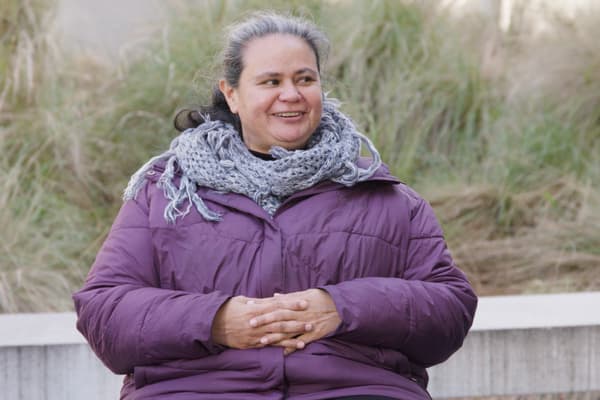Sculpture Garden
Media Kit

Artist interpretation of a proposed new Pavilion, photo by Choirender
Key information
The National Gallery has developed these online media kits for media usage only.
By downloading these images you are agreeing to the following:
Images are used exclusively by media, and only for purposes of publicity of the National Gallery of Australia, falling under the special exemptions of Fair dealing for purpose of reporting news or Fair dealing for purpose of criticism or review, as set out in the Copyright Act 1968; images must be accompanied by the provided caption; reproduction of images must respect the artist’s moral rights i.e., no cropping or overprinting on images.
Contact
For enquiries, please contact
media@nga.gov.au
The grounds that lie between the National Gallery and the shores of Lake Burley Griffin were configured to display the Gallery's extensive collection of sculpture.
After a few years in the planning, earthworks and plantings commenced on the National Gallery sculpture garden in 1981. Harry Howard and Associates and James Mollison, the Gallery's first Director, designed this garden to complement the building. The diagonal of the main pathway and the floor plan of the garden repeats the triangular architecture of the main building.
The innovative landscape design included a set of 'outside rooms' plantings that showcased 26 sculptures made by international and Australian artists. Most of the sculptures were bought and placed in the garden during the early 1980s and reflect the abstract, industrial aesthetic of that time, however there are some works that are more evocative, for example the fog sculpture by Fujiko Nakaya and the Pukamani burial poles nearby. Antony Gormley's life-sized maquette for Angel of the North which faces the lake, was a significant addition in 2010.
The plants are native to Australia and were selected for their tolerance of Canberra's severe winter conditions and long hot dry summers. The seasons of the year form the main design structure with the Winter garden close to the building with warm winter slate and winter flowering acacias and the earliest figurative works of art. The Summer garden is the shady area beneath the Casuarinas and near the marsh pond. The Spring garden, full of spring flowering Grevilleas and Acacias is closer to the lake. The Autumn garden was never fully realised.
Fujiko Nakaya's fog sculpture Foggy wake in a desert: An ecosphere is in operation 12.30pm – 2pm daily.
DOWNLOAD IMAGES
-

Artist interpretation of a proposed new Pavilion © Choirender Pty Ltd, photo by Choirender
-

Artist interpretation of proposed new Gallery forecourt and reflection pool, photo by Choirender.
-

Artist interpretation of proposed new garden room with diverse Shrubland planting, Image by Choirender Artist interpretation of a proposed new Pavilion © Choirender Pty Ltd, photo by Choirender
-

Artist interpretation of view from proposed new Pavilion, Image by Choirender.
-

National Sculpture Garden competition winning team: L-R Will Fung (CO-AP), Robert Champion (TARN), Phillip Arnold (Plus Minus Design), Johnny Ellice-Flint (Studio JEF), Liat Busqila (CO-AP), Photo supplied by the National Gallery of Australia, Kamberri/Canberra, photo by Sam Cooper
-

Annabelle Pegrum, advisor for the National Gallery Sculpture Garden Project, 2024.
-

Sculpture Garden Competition Finalists
Shortlisted entrants attend Stage Two briefing of the National Sculpture Garden Design Competition at the National Gallery of Australia, 19 June 2024. L-R: Adrian McGregor (McGregor Coxall); Sarah Hicks (Bush Projects); Simone Bliss (SBLA Studio); Sharon Wright (Hassell Ltd); and Will Fung (CO-AP). Credit: National Gallery of Australia
-

National Gallery of Australia, Kamberri/Canberra, Photographer: Rory Gardiner © National Gallery of Australia, 2023
-

Linda Marrinon, Woman in jumpsuit, 2022, National Gallery of Australia, Kamberri/Canberra, Commissioned with the generous support of Art Makers. Image courtesy of Linda Marrinon and Roslyn Oxley9 Gallery.
-

Dr Matilda House and Paul Girrawah House, Ngambri (Walgalu) – Wallaballooa (Ngunnawal) – Pajong (Gundungurra) – Wiradjuri (Erambie) peoples, Mulanggari yur-wang (alive and strong), 2021–22, commissioned by the National Gallery of Australia, Ngambri/Kamberri/Canberra for the 4th National Indigenous Art Triennial: Ceremony, purchased 2021, image courtesy and © the artists
-
Fujiko Nakaya, Foggy wake in a desert: An ecosphere, 1982, National Gallery of Australia, Kamberri/Canberra, purchased 1977 © Fujiko Nakaya
-

Clement Meadmore, Virginia, 1970, National Gallery of Australia, Kamberri/Canberra, purchased 1973 © Meadmore Sculptures, LLC. VAGA/Copyright Agency
-

Bert Flugelman, Cones, 1982, National Gallery of Australia, Kamberri/Canberra, commissioned 1976. Purchased 1982. © Bert Flugelman
-

Thanakupi (Thancoupie Gloria Fletcher AO), Dhaynagwidh/Thaynakwith people, Eran, 2010, acquired through the Founding Donors' Fund 2010 © the estate of the artist, licensed by Aboriginal Artists Agency Ltd.
-
Antony Gormley, Angel of the North (life-size maquette), 1996, National Gallery of Australia, Kamberri/Canberra, gift of James and Jacqui Erskine 2009 © the artist
-

Emile Bourdelle, Penelope, 1912, National Gallery of Australia, Kamberri/Canberra, purchased 1976
-
Mark di Suvero, Ik ook, 1971-72, National Gallery of Australia, Kamberri/Canberra, purchased 1979 © Courtesy of the artist and Spacetime CC
-
Lisa Roet, Orangutan Foot, 2007-2008, National Gallery of Australia, Kamberri/Canberra, gift of Richard and Jan Frolich 2015. Donated through the Australian Government's Cultural Gifts Program. © Lisa Roet
-

National Gallery of Australia, Kamberri/Canberra, Photographer: Rory Gardiner © National Gallery of Australia, 2023
-

Installation view Auguste Rodin, Nude study for Jean d'Aire, 1885-86 cast 1973, National Gallery of Australia, Kamberri/Canberra, purchased 1974, Photographer: Rory Gardiner © National Gallery of Australia, 2023
-

Installation view Tracey Emin, When I sleep, 2018, National Gallery of Australia, Kamberri/Canberra, purchased 2021 © Tracey Emin/Copyright Agency, Photographer: Rory Gardiner © National Gallery of Australia, 2023
-

Installation view Clement Meadmore, Virginia, 1970, National Gallery of Australia, Kamberri/Canberra, purchased 1973 © Meadmore Sculptures, LLC. VAGA/Copyright Agency, Photographer: Rory Gardiner © National Gallery of Australia, 2023
-

Installation view Bert Flugelman, Cones, 1982, National Gallery of Australia, Kamberri/Canberra, commissioned 1976. Purchased 1982. © Bert Flugelman, Photographer: Rory Gardiner © National Gallery of Australia, 2023

///national-gallery-of-australia/media/dd/images/09_New_Gallery_forecourt_and_Reflection_Pool.jpg)
///national-gallery-of-australia/media/dd/images/13_New_Garden_Rooms_set_within_diverse_Shrubland_planting.jpg)
///national-gallery-of-australia/media/dd/images/15_View_from_the_new_Pavilion.jpg)
///national-gallery-of-australia/media/dd/images/Sculpture_Garden_Finalists_001_uUiKSij.jpg)





























